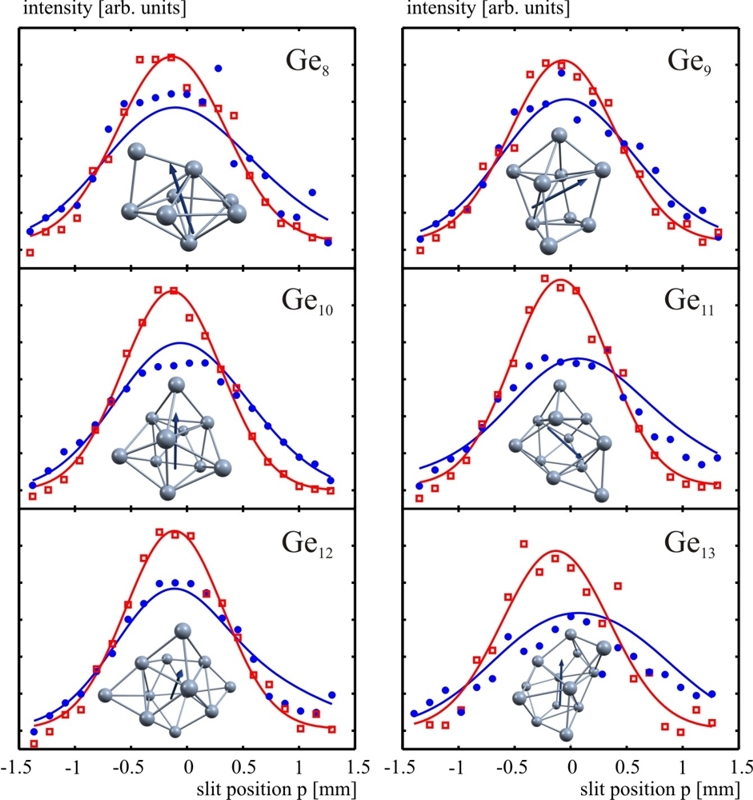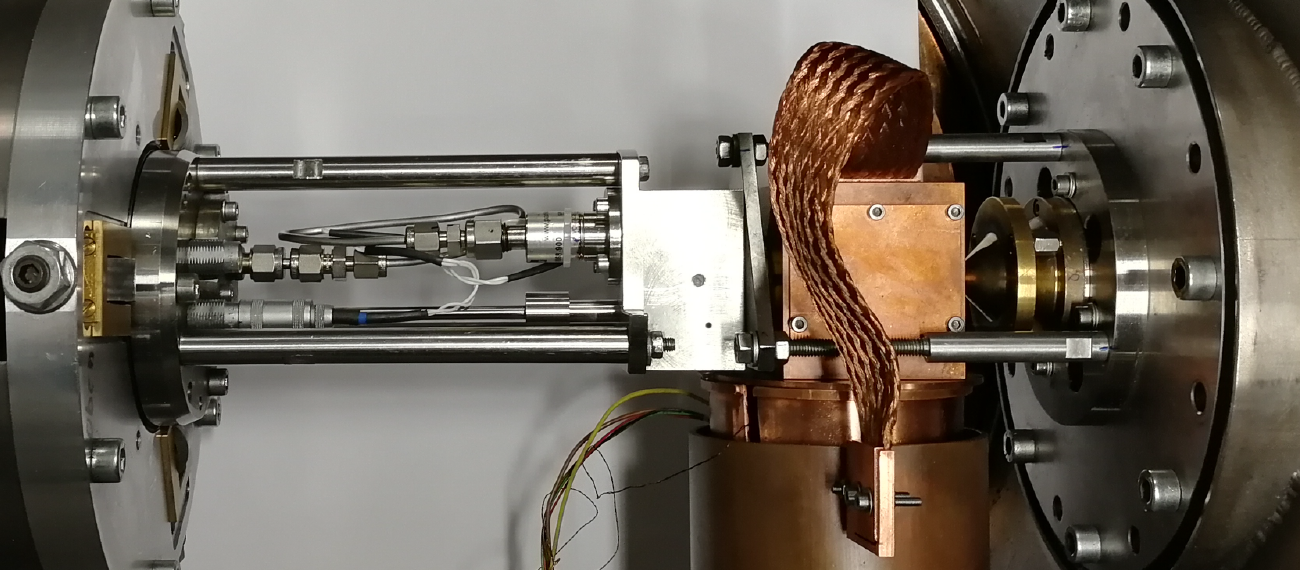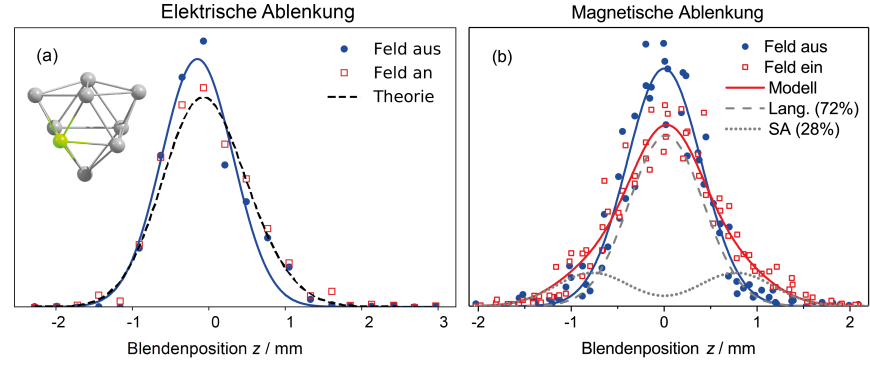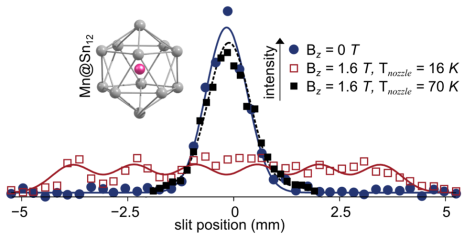Here, electric deflection profiles for SnN clusters (with N = 6-20) were observed. It was shown that most beam profiles can be represented by normal distributions in very good approximation. Furthermore, it could be observed that different cluster sizes show different effects in the electric field. For example, the Sn6 cluster shows only a shift but no broadening of the beam profile. This cluster therefore has no permanent dipole moment. The profile of the Sn10 cluster, in comparison, shows a clear broadening.
As mentioned before, MD simulations of clusters in the electric field can be used to validate or falsify the quantum-chemically determined geometric structure. Each isomer has an individual moment of inertia and permanent dipole moment, since these depend on the geometry. Fig. 1 shows the beam profiles for GeN clusters (with N = 8-13). Here, the intensities shown in red are recorded without field, while the dots in blue are recorded with the electric field switched on. The blue solid line is the beam profile generated by the MD simulation. Additionally, the global minimum structures are shown below..

Firstly, the beam profiles show a clear broadening in the electric field (blue points). Furthermore, it can be seen that the experimental data is described in very good approximation by the MD simulation. Thus, the combination of quantum chemical calculations and electric deflection experiments allows statements about the structure of small clusters.
Literature
S. Schäfer, B. Assadollahzadeh, M. Mehring, P. Schwerdtfeger, R. Schäfer, J. Phys. Chem. A 2008, 112, 12312–12319.
S. Schäfer, R. Schäfer, Phys. Rev. B 2008, 77, 205211.
S. Heiles, S. Schäfer, R. Schäfer, J. Chem. Phys. 2011, 135, 034303.
Within the framework of this project, both electric and magnetic deflection measurements and quantum chemical calculations were performed to study the size dependence of the doping effects in PMSnN clusters (M = 1, 2; N = 6-12). It is shown that phosphorus is initially incorporated into the framework of the tin cluster like a single negatively charged tin anion. The resulting structures for PSnN are similar to the anionic tin clusters SnN+1-. However, quantum chemical calculations predict that the electronic structure differs drastically. The phosphorus atom localises additional electron density and causes an uneven charge distribution in the doped cluster, while the electron density in anionic tin clusters is evenly distributed. It is therefore assumed that, in contrast to n-doping, the additional electron in the sub-nanoscale tin cluster cannot move freely.
Magnetic deflection measurements show in accordance with quantum chemical calculations that all investigated PSnN clusters are present as a dublette, while the the P2SnN clusters exist only in singlet states. Furthermore, a correlation between the magnetic deflection behavior of the single-doped clusters and their vibrational excitation could be observed. These depend on the stiffness of the vibrational modes and the thermalization of the cluster. Especially small clusters with hard vibrational modes (M = 1, N = 5, 6) show a significant superatomic fraction (SA), i.e. a splitting into 2J+1 = 2 partial beams.
Literature
M. Gleditzsch, T. M. Fuchs, R. Schäfer, J. Phys. Chem. A 2019, 123, 1434–1444.
A combined approach of electric deflection experiments and quantum chemical calculations is applied, to investigate the influence of doping tin clusters with a single gold atom on the structure and dielectric properties. For this purpose, the experimental results are compared with the structural isomers generated by a global optimization algorithm. It can be seen that from nine tin atoms onwards, a tin cage is formed around the gold atom. The geometrical structure of the gold-doped tin clusters are comparable to those of manganese-doped tin clusters. However, quantum chemical calculations show that the electronic structure differs drastically. Here it is shown for the first time that a dopant atom withdraws electron density from the tin cage, instead of adding it like manganese. This uneven distribution of the charge density leads to a Jahn-Teller distortion and reduced values of the electric dipole moment compared to manganese doping. Furthermore, it is shown that in gold-doped tin clusters spin-orbit effects can occur.
Literature
M. Gleditzsch, L. F. Pasteka, D. A. Götz, A. Shayeghi, R. L. Johnston, R. Schäfer, Nanoscale 2019, 11, 12878.
A particularly critical point in magnetic and electric deflection experiments is the thermalization of the rotational and vibrational degrees of freedom of the clusters in the molecular beam, since the experimental behaviour is fundamentally influenced by rotational and vibrational excitation. In simple words, the fewer vibrations are excited in the cluster, the easier it is to draw conclusions about the intrinsic properties of the clusters from the observed experimental data. Particularly impressive is the effect of the vibrational temperature in the Stern-Gerlach experiment on MnSn12: If the cluster is synthesized at a nozzle temperature of Tnozzle = 16 K, it behaves like an atom (superatomar) with S = 5/2, while the cluster beam at Tnozzle = 70 K undergoes a shift.
In a detailed analysis of the vibrational excitation it was shown that the experimentally observed transition between these two limiting cases can be quantitatively described, if it is assumed that the vibrational temperature is equal to the nozzle temperature, as long as T ≥ 30 K. Conversely, this experiment provides access to the vibrational temperature of certain cluster species in the molecular beam.
In this study, further clusters MnSnN with N = 9-16 were investigated and compared with quantum chemical calculations. These species differ fundamentally in their deflection behaviour. For example, the beam profile of MnSn11 at Tnozzle = 16 K shows a symmetric broadening, whereas for MnSn13 at the same nozzle temperature a beam shift in gradient direction but no broadening is observed. The magnitude of the molecular beam broadening was qualitatively related to the symmetry of the different cluster species. This correlation can be understood on a microscopic level by considering the intersections of Zeeman and rotational states.
Literature
U. Rohrmann, R. Schäfer, Phys. Rev. Lett. 2013, 111, 133401.
U. Rohrmann, P. Schwerdtfeger, R. Schäfer, Phys. Chem. Chem. Phys. 2014, 16, 23952–23966.
If two Stern-Gerlach magnets are arranged consecutively so that their field gradients are antiparallel to each other, a particle with a constant value of the projection of the magnetic dipole moment on the field direction would get deflected in the first magnetic field and refocused to the beam axis in the second magnet. However, if the spin state between the two magnets changes, the corresponding particle is not refocused. If this experiment is performed with an atomic beam, a practically complete refocusing is observed. In contrast, the superatomic cluster MnSn12 showed that even small changes in the flux density between the two deflection fields causes a significant deterioration of the refocusing. This observation was explained in a microscopic model that takes into account the intersections between rotational and Zeeman levels, which the cluster passes during its flight through the magnetic field. Due to the conservation of angular momentum, some of these state crossings are avoided, which is why under certain circumstances the spin state may change. The robustness of the spin state against external influences is a decisive feature with regard to possible applications of magnetic nanoparticles, for example in data storage technology.
Literature
T. Fuchs, R. Schäfer, Phys. Rev. A 2018, 98, 063411.











